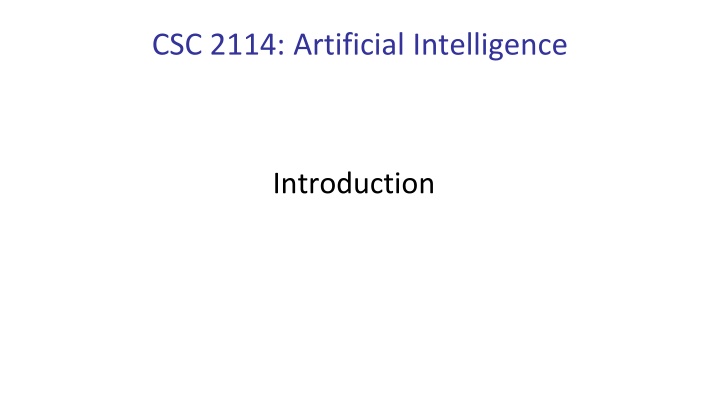
Artificial Intelligence Perspectives and Approaches
Explore the world of artificial intelligence through different perspectives and approaches, such as acting humanly and thinking humanly. Learn about defining AI systems, the Turing Test, and the role of cognitive science in understanding intelligence. Dive into the realm of AI with insights on how machines replicate human-like behaviors and problem-solving abilities.
Download Presentation

Please find below an Image/Link to download the presentation.
The content on the website is provided AS IS for your information and personal use only. It may not be sold, licensed, or shared on other websites without obtaining consent from the author. If you encounter any issues during the download, it is possible that the publisher has removed the file from their server.
You are allowed to download the files provided on this website for personal or commercial use, subject to the condition that they are used lawfully. All files are the property of their respective owners.
The content on the website is provided AS IS for your information and personal use only. It may not be sold, licensed, or shared on other websites without obtaining consent from the author.
E N D
Presentation Transcript
CSC 2114: Artificial Intelligence Introduction
Textbook Russell & Norvig, Artificial Intelligence: A Modern Approach, 3rd Ed.
Today What is artificial intelligence? Where are we and how did we get here? How do we think about the design of AI systems?
What is Artificial Intelligence Is a branch of science that deals with helping machines find solutions to complex problems in a more human like fashion Involves borrowing characteristics from human intelligence, and applying them as algorithms in a computer system.
Artificial Intelligence view Perspectives Intelligence perspective Making intelligent machines acting like we would expect people to act. Business perspective- provides a set of powerful tools and methodologies for using the tools to solve business problems. Programming perspective- study of symbolic programming, problem solving and search.
What is the definition of AI Systems? Systems that think like humans Systems that think rationally Systems that act like humans Systems that act rationally
Approach 1: Acting Humanly Act like a person Turing test: ultimate test for acting humanly Computer and human both interrogated by judge Computer passes test if judge can t tell the difference
How effective is this test? Agent must: Have command of language Have wide range of knowledge Demonstrate human traits (humor, emotion) Be able to reason Be able to learn Loebner prize competition is modern version of Turing Test Example: Alice, Loebner prize winner for 2000 and 2001
Approach 2: Thinking Humanly Think like a person Requires knowledge of brain function What level of abstraction? How can we validate this This is the focus of Cognitive Science ( investigation of the mind and Intelligence).
Approach 3: Thinking Rationally Model thinking like a logical process where conclusions are drawn based on some logic of symbolic logic. What are correct arguments or thought processes? Provided foundation of much of AI Not all intelligent behavior controlled by logic What is our goal? What is the purpose of thinking?
Approach 4: Acting Rationally Act to achieve goals, given set of beliefs Rational behavior is doing the right thing Thing which expects to maximize goal achievement This is approach adopted by Russell & Norvig
Foundations of AI Philosophy 450 BC, Socrates asked for algorithm to distinguish pious from non-pious individuals Aristotle developed laws for reasoning Mathematics 1847, Boole introduced formal language for making logical inference Economics 1776, Smith views economies as consisting of agents maximizing their own well being (payoff) Neuroscience 1861, Study how brains process information Psychology 1879, Cognitive psychology initiated Linguistics 1957, Skinner studied behaviorist approach to language learning
A short prehistory of AI Prehistory: Philosophy (reasoning, planning, learning, science, automation) Mathematics (logic, probability, optimization) Neuroscience (neurons, adaptation) Economics (rationality, game theory) Control theory (feedback) Psychology (learning, cognitive models) Linguistics (grammars, formal representation of meaning) Near miss (1842): Babbage design for universal machine Lovelace: a thinking machine for all subjects in the universe.
AIs official birth: Dartmouth, 1956 An attempt will be made to find how to make machines use language, form abstractions and concepts, solve kinds of problems now reserved for humans, and improve themselves. We think that a significant advance can be made if we work on it together for a summer. John McCarthy and Claude Shannon Dartmouth Workshop Proposal
A (Short) History of AI 1940-1950: Early days 1943: McCulloch & Pitts: Boolean circuit model of brain 1950: Turing's Computing Machinery and Intelligence 1950 70: Excitement: Look, Ma, no hands! 1950s: Early AI programs: chess, checkers (RL), theorem proving 1956: Dartmouth meeting: Artificial Intelligence adopted 1965: Robinson's complete algorithm for logical reasoning 1970 90: Knowledge-based approaches 1969 79: Early development of knowledge-based systems 1980 88: Expert systems industry booms 1988 93: Expert systems industry busts: AI Winter 1990 2012: Statistical approaches + subfield expertise Resurgence of probability, focus on uncertainty General increase in technical depth Agents and learning systems AI Spring ? 2012 ___: Excitement: Look, Ma, no hands again? Big data, big compute, deep learning AI used in many industries
AI as Designing Rational Agents An agent is an entity that perceives and acts. A rational agentselects actions that maximize its expected utility. Characteristics of the sensors, actuators, and environment dictate techniques for selecting rational actions This course is about: General AI techniques for many problem types Learning to choose and apply the technique appropriate for each problem Environment Sensors Percepts Agent ? Actuators Actions Pac-Man is a registered trademark of Namco-Bandai Games, used here for educational purposes
Agents and environments Agent Environment Sensors Percepts ? Actuators Actions An agent perceives its environment through sensors and acts upon it through actuators (or effectors, depending on whom you ask) The agent function maps percept sequences to actions It is generated by an agent program running on a machine
PEAS: Automated taxi Performance measure Income, happy customer, vehicle costs, fines, insurance premiums Environment Ugandan streets, other drivers, customers, weather, police Actuators Steering, brake, gas, display/speaker Sensors Camera, radar, accelerometer, engine sensors, microphone, GPS Image: http://nypost.com/2014/06/21/how-google- might-put-taxi-drivers-out-of-business/
PEAS: Medical diagnosis system Performance measure Patient health, cost, reputation Environment Patients, medical staff, insurers, courts Actuators Screen display, email Sensors Keyboard/mouse
Environment Properties Fully observable vs. partially observable Deterministic vs. stochastic / strategic Episodic vs. sequential Static vs. dynamic Discrete vs. continuous Single agent vs. multi-agent Known physics? Known perf. measure?
Agent design The environment type largely determines the agent design Partially observable => agent requires memory (internal state) Stochastic => agent may have to prepare for contingencies Multi-agent => agent may need to behave randomly Static => agent has time to compute a rational decision Continuous time => continuously operating controller Unknown physics => need for exploration Unknown perf. measure => observe/interact with human principal
Agent Types Types of agents (increasing in generality and ability to handle complex environments) Simple reflex agents Reflex agents with state Goal-based agents Utility-based agents Learning agent
Simple reflex agents Agent Sensors Use simple if then rules Can be short sighted What the world is like now Environment SimpleReflexAgent(percept) state = InterpretInput(percept) rule = RuleMatch(state, rules) action = RuleAction(rule) Return action What action I should do now Condition-action rules Actuators
Pacman agent program in Python class GoWestAgent(Agent): def getAction(self, percept): if Directions.WEST in percept.getLegalPacmanActions(): return Directions.WEST else: return Directions.STOP
Reflex agents with state Store previously-observed information Can reason about unobserved aspects of current state Sensors State What the world is like now How the world evolves Environment ReflexAgentWithState(percept) state = UpdateDate(state,action,percept) rule = RuleMatch(state, rules) action = RuleAction(rule) Return action What my actions do What action I should do now Condition-action rules Agent Actuators
Goal-based agents Goal reflects desires of agents May project actions to see if consistent with goals Takes time, world may change during reasoning Sensors State What the world is like now How the world evolves Environment What it will be like if I do action A What my actions do What action I should do now Goals Agent Actuators
Utility-Based Agents Evaluation function to measure utility f(state) -> value Useful for evaluating competing goals
Summary An agent interacts with an environment through sensors and actuators The agent function, implemented by an agent program running on a machine, describes what the agent does in all circumstances Rational agents choose actions that maximize their expected utility PEAS descriptions define task environments; precise PEAS specifications are essential and strongly influence agent designs More difficult environments require more complex agent designs and more sophisticated representations





